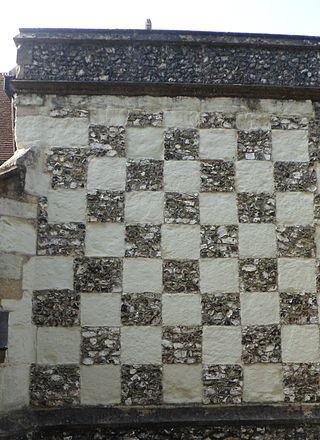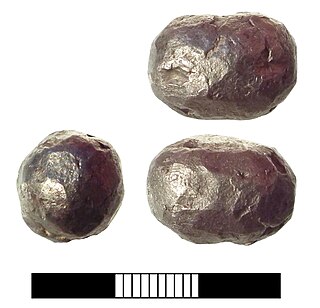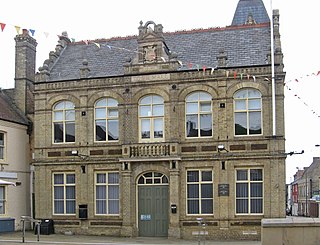
Flint, occasionally flintstone, is a sedimentary cryptocrystalline form of the mineral quartz, categorized as the variety of chert that occurs in chalk or marly limestone. Historically, flint was widely used to make stone tools and start fires.

Slate is a fine-grained, foliated, homogeneous, metamorphic rock derived from an original shale-type sedimentary rock composed of clay or volcanic ash through low-grade, regional metamorphism. It is the finest-grained foliated metamorphic rock. Foliation may not correspond to the original sedimentary layering, but instead is in planes perpendicular to the direction of metamorphic compression.

Stonemasonry or stonecraft is the creation of buildings, structures, and sculpture using stone as the primary material. Stonemasonry is the craft of shaping and arranging stones, often together with mortar and even the ancient lime mortar, to wall or cover formed structures.

Dry stone, sometimes called drystack or, in Scotland, drystane, is a building method by which structures are constructed from stones without any mortar to bind them together. A certain amount of binding is obtained through the use of carefully selected interlocking stones.

Downham Market, sometimes simply referred to as Downham, is a market town and civil parish in Norfolk, England. It lies on the edge of the Fens, on the River Great Ouse, approximately 11 miles south of King's Lynn, 39 miles west of Norwich and 30 miles north of Cambridge.

Clunch is a traditional building material of chalky limestone rock used mainly in eastern England and Normandy. Clunch distinguishes itself from archetypal forms of limestone by being softer in character when cut, such as resembling chalk in lower density, or with minor clay-like components.

Galleting, sometimes known as garreting or garneting, is an architectural technique in which spalls are pushed into wet mortar joints during the construction of a masonry building. The term comes from the French word galet, which means "pebble." In general, the word "galleting" refers to the practice while the word "gallet" refers to the spall. Galleting was mostly used in England, where it was common in South East England and the county of Norfolk.

Lime mortar or torching is a masonry mortar composed of lime and an aggregate such as sand, mixed with water. It is one of the oldest known types of mortar, used in ancient Rome and Greece, when it largely replaced the clay and gypsum mortars common to ancient Egyptian construction.

Structural dampness is the presence of unwanted moisture in the structure of a building, either the result of intrusion from outside or condensation from within the structure. A high proportion of damp problems in buildings are caused by ambient climate dependent factors of condensation and rain penetration. Capillary penetration of fluid from the ground up through concrete or masonry is known as "rising damp" and is governed by the shape and porosity of the construction materials through which this evaporation-limited capillary penetration takes place. Structural damp, regardless of the mechanisms through which it takes place, is exacerbated by higher levels of humidity.

Mucking is a hamlet and former Church of England parish and civil parish adjoining the Thames Estuary in the Thurrock unitary authority area, in southern Essex, England. It is located approximately 2 miles (3.2 km) south of the town of Stanford-le-Hope. In 1931 the civil parish had a population of 498.

Damp proofing in construction is a type of moisture control applied to building walls and floors to prevent moisture from passing into the interior spaces. Dampness problems are among the most frequent problems encountered in residences.
In metallurgy, refining consists of purifying an impure metal. It is to be distinguished from other processes such as smelting and calcining in that those two involve a chemical change to the raw material, whereas in refining, the final material is usually identical chemically to the original one, only it is purer. The processes used are of many types, including pyrometallurgical and hydrometallurgical techniques.

The following outline is provided as an overview of and topical guide to mining:
Mining archaeology is a specific field well-developed in the British Isles during recent decades. A reason of ongoing interest in this field is the particular bond between regional history and the exploitation of metals. References to mines in the area exist in Strabo's works. However the first accomplished study on the topic was attempted by Oliver Davies in 1935. Other momentous researches were that of geologist John S. Jackson about mines in Ireland and Lewis, Jones in Dolaucothi goldmine in Wales, and the pioneering work of Ronald F. Tylecote. Moreover, in the 1980s and 1990s a new generation of amateurs and scientists began investigations in different locations in the British Isles, including Duncan James on the Great Orme's Head, Simon Timberlake with the Early Mines Research Group at sites in Wales and William O'Brien in Ireland.

Metals and metal working had been known to the people of modern Italy since the Bronze Age. By 53 BC, Rome had expanded to control an immense expanse of the Mediterranean. This included Italy and its islands, Spain, Macedonia, Africa, Asia Minor, Syria and Greece; by the end of the Emperor Trajan's reign, the Roman Empire had grown further to encompass parts of Britain, Egypt, all of modern Germany west of the Rhine, Dacia, Noricum, Judea, Armenia, Illyria, and Thrace. As the empire grew, so did its need for metals.
Experimental archaeometallurgy is a subset of experimental archaeology that specifically involves past metallurgical processes most commonly involving the replication of copper and iron objects as well as testing the methodology behind the production of ancient metals and metal objects. Metals and elements used primarily as alloying materials, such as tin, lead, and arsenic, are also a part of experimental research.
Plano-convex ingots are lumps of metal with a flat or slightly concave top and a convex base. They are sometimes, misleadingly, referred to as bun ingots which imply the opposite concavity. They are most often made of copper, although other materials such as copper alloy, lead and tin are used. The first examples known were from the Near East during the 3rd and 2nd Millennia BC. By the end of the Bronze Age they were found throughout Europe and in Western and South Asia. Similar ingot forms continued in use during later Roman and Medieval periods.

Blakeney Chapel is a ruined building on the coast of North Norfolk, England. Despite its name, it was probably not a chapel, nor is it in the adjoining village of Blakeney, but rather in the parish of Cley next the Sea. The building stood on a raised mound or "eye" on the seaward end of the coastal marshes, less than 200 m (220 yd) from the sea and just to the north of the current channel of the River Glaven where it turns to run parallel to the shoreline. It consisted of two rectangular rooms of unequal size, and appears to be intact in a 1586 map, but is shown as ruins in later charts. Only the foundations and part of a wall still remain. Three archaeological investigations between 1998 and 2005 provided more detail of the construction, and showed two distinct periods of active use. Although it is described as a chapel on several maps, there is no documentary or archaeological evidence to suggest that it had any religious function. A small hearth, probably used for smelting iron, is the only evidence of a specific activity on the site.

St Peter and Paul's Old Cathedral is a heritage-listed former Catholic cathedral and now parish church at 42 Verner Street, Goulburn, Goulburn Mulwaree Council, New South Wales, Australia. It was designed by Andrea Stombuco and Charles Spadacini and built from 1871 to 1890 by C. J. O'Brien and Wilkie Bros. It is also known as St. Peter and Paul's Former Cathedral and St Peter and Paul's Catholic Cathedral; Saints Peter and Paul's Catholic Cathedral. It was added to the New South Wales State Heritage Register on 20 April 2009.

Downham Market Town Hall is a municipal building in Bridge Street, Downham Market, Norfolk, England. The structure, which is managed by Downham Market Town Council, is a Grade II listed building.



















